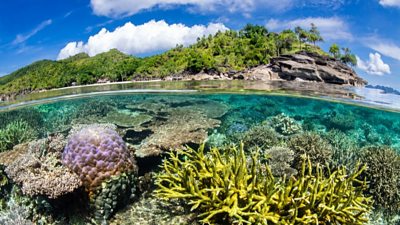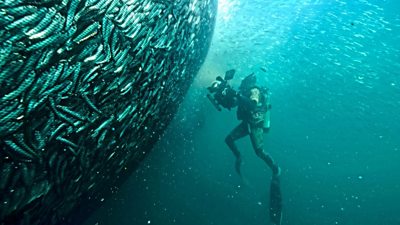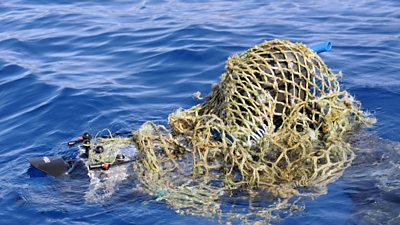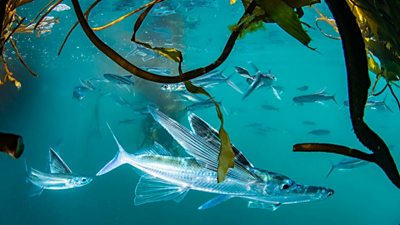Planet Earth III Episode 2 Ocean
Published: 24 October 2023
 Much of our planet still remains unexplored, for most of it is covered by water. Every journey below the surface can reveal something extraordinary - more than a thousand new species are discovered here every year.
Much of our planet still remains unexplored, for most of it is covered by water. Every journey below the surface can reveal something extraordinary - more than a thousand new species are discovered here every year.The ocean is home to eighty per cent of all animal life on Planet Earth, but today, thriving in this vast and varied world sometimes demands the most surprising behaviour..." -- Sir David Attenborough
The ocean covers two thirds of the planet and is home to 80% of all animal life,* yet much of it remains unexplored. In this episode, we join David Attenborough on a journey through the vast and changing ocean to reveal the extraordinary behaviours and remarkable adaptations required for life to survive here. For life beneath the surface, the ocean can be a battlefield.
In the shallow seas of the tropics a lionfish is fatally ensnared by a shrimp-like lure, seductively dangled from the head of a cunning clown frogfish. In the giant kelp forests off North America, a young horn shark is ambushed and swallowed whole by an angel shark - which may have bitten off more than it can chew - and out in the empty big blue, flying fish search for floating seaweed to lay their eggs but end up attracting the attention of hungry blue sharks. Today, islands of seaweed are being replaced by plastic - every year 12 million tons of it ends up in the ocean.* It is lethal to many (and the crew had to rescue many entangled turtles while filming), but Columbus crabs are making a home on these unnatural rafts.
The crabs, however, are poor swimmers, so to find a mate, they must hitch a lift. Passing turtles can help and in fact provide a permanent home for a pair of crabs - in return the crabs provide an onboard grooming service. The relationship that works so well, these turtles are often joined by a pair of crabs.
Finding a partner in the ocean is not always this easy. In the Sea of Cortez, mobula rays perform astounding, acrobatic leaps that appear to attract other rays - but the performance also attracts a family of specialist ray-hunting orca that have a unique hunting strategy. Theleast known parts of the ocean are its great depths, which can only be reached using specialised submersibles.
As we descend and sunlight fades, alien-like creatures appear, including a massive siphonophore - the longest animal on planet earth; and a gulper eel with huge jaws that can engulf prey larger than its own body. Two miles below the surface, we reach the ocean floor where the pressure is crushing and the temperature is freezing cold . A mother octopus heads to a special place where warm water escaping from the seabed creates a thermal spa.
Here she joins twenty thousand female octopus, all here to raise their eggs - the largest known gathering of octopus on planet earth.* It will take two years for their eggs to develop and in that time these devoted mothers will not even leave them to feed. An extreme effort after which they will die, but meaning their young are the most developed of any octopus - vital in the demanding world of the deep. In today's ocean, animals are having to compete with humans.
But some are learning to take advantage. Off the coast of Chile, thousands of South American sea lions raid fishermen's nets - but it comes with a huge risk. As the net is drawn in, the sea lions must get out quickly or risk being crushed and drowned.
Animals have evolved in remarkable ways to the demands of life in the ocean. But can they now adapt to the new challenge... living alongside us? AT2/NM3
Filming locations and species

- Pretitle: Nassau, Bahamas
- Frogfish: Dauin, Philippines
- Horn shark and angel shark: California, USA
- Flying fish: Iquique, Chile
- Columbus crabs: the ocean off the Canary Islands
- Orca vs mobula rays: Sea of Cortez, Mexico
- Glass squid: The deep sea off the Azores
- Gulper eel: The deep sea off Madeira
- Plankton: The coast of Belgium and Holland
- Octopus nursery: The deep sea off the coast of California, USA
- Sea lions and anchovies: Off the coast of Mejillones, Chile
Key metrics
In numbers...
- Number of shoots: 16
- Number of shoots managed remotely: Seven
- Number of filming days: 175
- Lowest point filmed: Two miles beneath the surface of the ocean.*
- Fun fact: The surface of Mars is better mapped than the ocean floor.*
Rarest species documented...
- Giant sea bass (stereolepis gigas): critically endangered
- Tope shark / school shark (Galeorhinus Galeus): critically endangered
- Loggerhead sea turtle (Caretta caretta): endangered
- Snipe eel, glass squid, gulper eel: extremely rare to see
- Pearl octopus (muusoctopus robustus): only found in the deep sea
Meet the team

Tom Greenhalgh, Assistant Producer, Ocean
Tom Greenhalgh is the Director on the Deserts and Grasslands episode and the Assistant Producer on the Ocean episode of Planet Earth III. Growing up in Kent and fascinated by the natural world from a young age, he completed a BSc in Zoology and a MA in Wildlife Documentary Production. Since 2012, his films have taken him all over the world, from filming orca in the Arctic Circle, to nesting ostriches in the Namib Desert.
He's worked on VFX programmes about prehistoric creatures, children's wildlife shows for CBBC, and landmark documentaries for National Geographic the BBC Natural History Unit. His favourite animals, both to film and observe, are gibbons - acrobatic singing apes living in the rainforests of southeast Asia.
Q&A with Will Ridgeon, Producer and Director

Will is an award-winning producer and director, who has worked at the BBC's Natural History Unit for 14 years - producing a wide range of natural history series and specialising in creating landmark wildlife films. As producer on the critically acclaimed series, Blue Planet II, Will worked extensively across The Deep and Coast episodes as well as delivering the final environmental film, Our Blue Planet, presented by David Attenborough.
This saw him spending over 100 hours in deep-sea submersibles filming giant shark feeding frenzies and erupting methane volcanoes. Equally as happy below the water as above, Will has spent the last four years diving in seas around the world, to produce the Ocean episode for Planet Earth III. What is this episode all about?
This film is a journey through the least known part of our planet - from the sunlit shallow seas, through the vast open ocean and down to the mysterious depths. We wanted to reveal the extraordinary ways life has evolved to survive and thrive in these varied habitats, and ultimately how animals in today's ocean are now having to adapt to the changes that we are making to their world. What was your most surprising moment when filming the episode?
When we set out to film sea lions raiding anchovies from fishing nets in Chile I thought I had a good idea of what to expect, but nothing could have prepared me for what we saw. Anchovies can be anywhere along thousands of miles of rugged coastline, and they are constantly moving - unencumbered by country borders, customs zones, or tonnes of equipment, unlike the film crew! After many days of searching and following numerous leads, we finally tracked them down.
The sheer scale of what's going on there was astounding, I have never been amongst so many animals - thousands of sea lions climbing over each other to get at the anchovies in the net - the noise and energy was breath-taking - it was chaos. We had to be very careful putting divers into the situation. As the net tightens the fishermen make noise to warn the sealions it is time to leave the nets, but we repeatedly saw young sea lions getting trapped - there really isn't much the fishermen can do.
It was extremely hard to watch, and we came across dead sea lions and birds floating in the water. It is hear- breaking and shows the huge risks these animals are having to take. There is a sequence in which an angel shark surprises its prey, an unsuspecting young horn shark.
What was it like to capture the angel shark strike? Angel sharks can lie in wait for days before striking, with a sudden lunge faster than the blink of a human eye. To film this sequence we worked with local crews, who spent months trying to capture these lightning fast strikes.
They used specialist 'rebreather' diving systems which allowed them to stay underwater for hours and produce no bubbles that might scare off the fish, and high-speed cameras with a 'pre-record' function capable of capturing the lightning fast moment even if you press record fractionally after the strike. Then it was just a case of sitting and waiting. In the episode the audience is taken all the way down to the deep abyss.
How much of a challenge was it to film in the depths of the ocean? The deep sea must be one of the hardest places on earth to film, and one of the most ambitious sequences in the whole series was to capture the intimate moments in the life of octopus mothers - two miles deep at the bottom of the ocean. It took many filming trips over two years, and wouldn't have been possible without the skills and expertise of the team at the Monterey Bay Aquarium Research Institute (MBARI) - the crew of skilled remotely operated vehicle (ROV) pilots and deep-sea experts, led by Jim Barry.
The ROV is bigger than most cars*, and manoeuvring it carefully around the delicate brooding octopus took huge skill from the MBARI pilots - often in very heavy seas. The crew had to control the camera and position the lights from the boat, two miles above - using the ROV's two robotic arms. Every time we needed to reposition the camera or lights it could take at least 20 minutes to get right, so capturing the moment the eggs hatch and the young octopus swim off was a real challenge - and an amazing moment when we got it.
It is a real privilege to have spent so much time watching these remarkable animals, living in such an alien and hostile world. The episode concludes with the alarming rate in which marine animals are struggling to adapt to rapid manmade changes. What do you want audiences to take away from this?
Filming in the ocean, it is very clear to see how things are changing and the increasing impact humans are having. We wanted to show how amazing life in the ocean is but also how fragile it can be. These animals are often out of sight to us, but they are being greatly affected by human activity.
Key stories and filming feats

Pearl Octopus Nursery
Off the coast of California, USA
NB: filming feat; new technology; new discovery The team worked with MBARI to film an intimate portrayal of the life of deep sea octopus, two miles down in the recently discovered Octopus Garden. This is the first filming of its kind - previously the only footage of this has been from scientific expeditions.
It includes the rare moment that the baby octopus hatch and swim off into the deep. The Octopus Garden, as it is known, was discovered in 2018 and is thought to be the largest gathering of octopus in the world - 20,000 expectant mothers crowd along thermal springs in the deep seabed. Without the heat from this thermal spa, their eggs may take over 10 years to develop.
Even so they still take two years - during which time the females will not leave their eggs, even to feed. It is an ordeal that will eventually kill them. To capture this extremely special story, the Planet Earth IIIteam filmed with MBARI aboard the R/V Western Flyer, using their state of the art Deep Sea ROV (remotely operated vehicle), Doc Ricketts.
The latest deep-sea cameras were used, and specialist equipment such as moveable lights and 'quad pods' were specially developed. Filming took almost two years, and multiple filming trips to the deep sea, using the remotely operated Doc Ricketts' two robotic arms to painstakingly manoeuvre the cameras and lights around the octopus. Jim Barry (Lead MBARI Scientist): "After spending so much time at sea studying these octopus moms and even more time reviewing video, I feel I've begun to understand the mother's struggle to protect the developing brood as they march toward the end of their own life.
Initially, the startling view of hundreds of octopus right in front of you is overwhelming, but with time, the plodding pace of life, their nuanced behaviour to tend their eggs in the wafting warm waters, and the evident toll of brooding on these mothers has captured my attention. For me, they became individuals, even friends." "It can be incredibly difficult to perform even simple tasks using robots two miles beneath the surface.
It is dark, cold, and a long way down with immense pressures. All of our gear has to handle these conditions. All systems - navigation, propulsion, robotic arms, sensors, tools, cameras, software, pressure housings - and all else must work at the seabed miles down, and all the way up the cable to the ROV control room."
Columbus Crabs
The ocean off the Canary Islands
NB: filming feat

Despite not being able to swim very well, Columbus crabs live in the open ocean - making their home on floating objects such as sargassum seaweed. In today's oceans however they are thriving on plastic rubbish and discarded fishing nets that are replacing floating seaweed. Finding a crab the size of your thumbnail in the vastness of the open ocean is like looking for a needle in a haystack, and filming took many months over a two year period.
Once found, the camera team developed a number of ingenious methods to film undetected - dressing up as floating plastic! While Columbus crabs are thriving on plastic and discarded materials, other larger animals are particularly at risk from these 'ghost nets' and the crew came across a number of entangled turtles. They were able to rescue all but one.
Fun fact: To film the turtles unnoticed and without affecting their behaviour, the cameraman disguised himself as an old, discarded net. Rafa Herrero Massieu (Cameraman): "It was very challenging to film the sequence and it took many days - the entire summer of two years. We went out into open waters every day and sailed at a slow pace for hours to find turtles and the crabs living on them.
Out of the nearly one thousand sightings, only a few of them allowed us to film them. We employed various techniques, such as hiding behind a camouflage net or using a homemade device to achieve macro shots in open waters, but the one that worked best was practising patience: when we had a sighting, we would float at a distance and wait for the turtle to come to us. When the encounter happened, it was magical.
Unfortunately, plastics in open waters have replaced natural objects such as tree trunks, branches, or shrubs. During each outing, we practically filled our boat with waste. Experiencing this was disheartening.
In an environment already lacking in shelter, a floating net becomes both refuge and sustenance for many of its inhabitants, but also an everlasting death trap. We encountered at least eight turtles trapped in nets or plastics and while we were able to release some of them without apparent harm, others had to be transferred to the Wildlife Recovery Center in Tenerife. Unfortunately, one of them didn't survive.
It was always in our thoughts, all those turtles condemned to an agonising and cruel death for months in the middle of nowhere, without anyone being able to help them."
Horn shark and angel shark
California, USA NB: filming feat; new technology The Planet Earth III team worked with local camera operators over three years to capture the lightning fast strike of the angel shark, and the remarkable defence of a young horn shark.
They used the latest high-speed cameras to slow down the action, giving a unique view of this rare moment. Angel sharks are the kelp forest's ultimate ambush predator - lying in wait for days before striking, with a lunge faster than the blink of a human eye. Local crews spent three years waiting and watching to film the extraordinary moment an angel shark grabs a horn shark, swallowing it whole.
But a horn shark has sharp spines on its back to protect it, and as a result the angel shark immediately spits it out unharmed. The divers used the latest 'rebreather' systems - specialist diving equipment that allowed them to stay underwater for up to four hours and produce no bubbles that could scare off any fish. Jeff Hester (Cameraman) on waiting for the angel shark to strike: "It took tons of patience and we had to be constantly aware, you never knew when a fish was going to miscalculate the distance to the shark and wind up in its mouth.
On dives where we were able to get a strike, we reached the three hour mark before we had any action, and some dives saw nothing. "The strike when it happens is incredibly fast, we were shooting at 120 frames per second which is about five times slower than reality, and the catches still appear to happen in the blink of an eye. You would never guess that the shark could move that fast just by looking at it.
"We used rebreathers to do dives up to four hours long which really allowed us to settle into a filming spot and blend in with the environment. Rebreathers are great because you don't exhale bubbles like you do with conventional SCUBA so you're almost silent, allowing the animals to get completely comfortable with your presence and carry on with their activities."
Flying Fish
Iquique, Chile NB: filming feat, new behaviour

The Planet Earth III team filmed blue sharks feeding on a raft of flying fish eggs which are an energy rich part of these sharks' diet.
It is the first time this behaviour has been filmed, to the best of our knowledge. In the vast emptiness of the open ocean, flying fish rely on floating islands of kelp to lay their eggs. Finding shelter in the big blue is a rare opportunity, and the fish spawn enthusiastically - laying hundreds of thousands of eggs.
This attracts blue sharks, which feast on the energy rich eggs. In order to film this unique event, the crew spent many weeks on a small South American fishing boat, floating in the open ocean searching for a needle in a haystack! John Chambers (Sequence Director): "Most shoots in the open ocean have one thing in common and that's a lot of waiting around; be that for good weather or just to find the animals.
The freshest thing for me on this shoot was seeing the blue shark eat the flying fish eggs, which we didn't manage to get until the very last morning of the shoot. The shark sucks the eggs up like spaghetti or tears pieces off like candy floss; it's so unusual to see a shark eat in this way. The scale of the egg laying was so huge that even after the shark feasted on the eggs and had its fill, the kelp rafts themselves are still covered in eggs - it reminded me of a house dressed in cobwebs at Halloween.
After spending the last 15+ years filming in the open ocean these were truly new and exciting things to experience first-hand!" On filming the flying fish's impressive gliding: "Once we'd finally found the flying fish, the problem was that they could fly out of the water from anywhere, and in any direction. Initially it just seems impossible that you'll be pointing in the right direction, the fish will be in frame and they'll be in focus...
Amazingly, after a lot of initial trial and error, our cameraman Sam Lewis got to the point where four out of five shots were usable. I don't know how he did it!" Notes
Planet Earth III, an 8x60' series made by BBC Studios Natural History Unit, co-produced by BBC America, ZDF, FTV and The Open University. Sources * The vast and varied oceans support 80% of all animal life on planet earth. [Bar-On, 2018: "The Biomass Distribution on Earth".]
* Every year 12 million tons of plastic ends up in the ocean. [Kosior, Edward, and Irene Crescenzi. "Solutions to the plastic waste problem on land and in the oceans." Plastic waste and recycling. Academic Press, 2020.
415-446.] * With an estimated 20,000 individuals, this is the largest known gathering of octopus in the world - it was only discovered in 2018.
These octopus were previously thought to be solitary. [James P. Barry et al Abyssal hydrothermal springs - cryptic incubators for brooding octopus (2023)] * Lowest point filmed: two miles beneath the surface of the ocean [Dr Jim Barry, 2023]
* The surface of Mars is better mapped than the ocean floor. [Dr Jon Copley.
Professor of Ocean Exploration and Science Communication, University of Southampton http://www.joncopley.com/blog_oct14.html]
* The ROV is bigger than most cars [average UK car volume is less than 9.5 cubic metres, the ROV is 14.3 cubic metres].